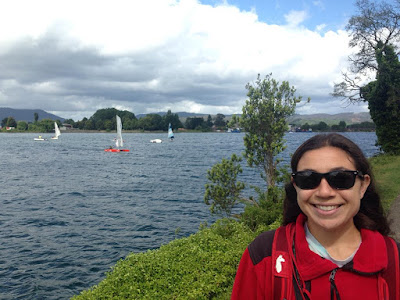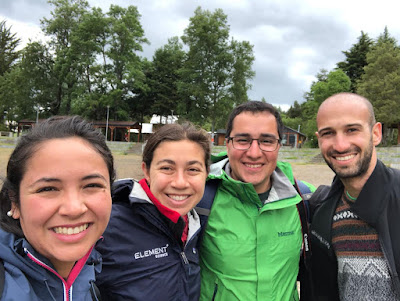When I (Karen) lived near Temuco in 2011, everyone always mentioned it was fun to go visit the "termas" or hot springs a couple of hours away. I never actually made it because of the distance and price (they cost up to $50USD/day!). However, upon setting foot in Pucón it was clear I had a second chance to visit the famed hot springs. After stopping by the town visitor center, we got a map of the surrounding area: it was COVERED in this icon.

There are about 20 different resorts all featuring hot springs. The city map lists the temperature ranges of each location's springs, along with phone numbers and hours (if known) to allow for some easy comparison shopping. I had no idea there were so many options, but I guess it makes sense- since the area has a lot of active volcanoes and lakes I guess it makes sense that some of the lakes are warm. With so much competition, the hot springs really try to differentiate themselves. Some make deals with tour companies to bus people in from town. Others brand themselves as high-end with luxury facilities, dining, lodging etc.
I opted for Pozones, one of the most economical options ($10 USD) and accessible by bus ($6USD round trip). It was recommended by our Airbnb hosts. I never particularly feel the need to visit hot springs, but given how beat I was from the hike at Huerquehue the previous day, it seemed like a good option, and it was! My one complaint is that you have to walk a good 15-minutes down a steep-ish gravel path to get to the actual hot springs. My aching knees and legs did not appreciate the mini-hike.
Pozones has about 5 pools, each with a different temperature. I watched two French tourists (who were the only other people on the bus with me) head straight into the hottest pool. They didn't last more than 5 minutes, knee-deep, before they got out, salmon pink. I dipped an ankle in and concurred. This was the first natural hot-spring I've been to where the water was decidedly too hot. Normally, I wish the water were a little warmer, but Pozones does not disappoint! The middle three pools are a great temperature.
The grounds border a scenic river, and the surrounding woods aren't far from Huerquehue National Park, so much of the foliage is similar. Here's a video I took upon arrival.
Since I didn't want to take too many pictures with all the water, here are a couple I nabbed from Google.
 |
| Photo from TripAdvisor |
 |
| Photo from Tourismo Transfer San Luis |



















































